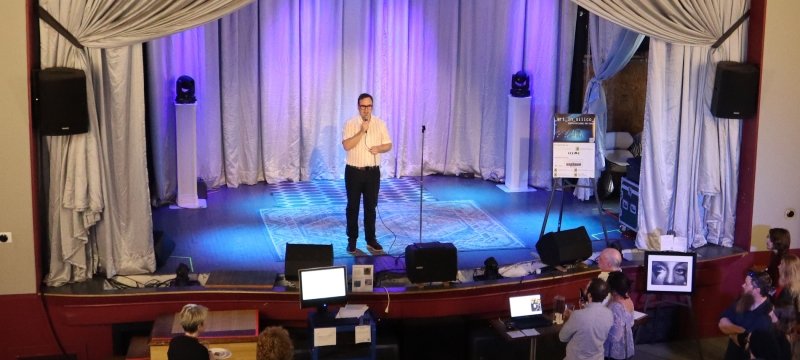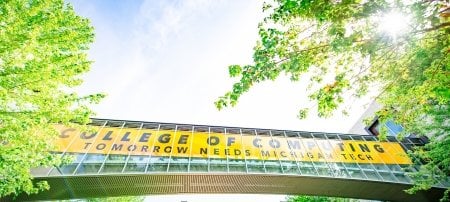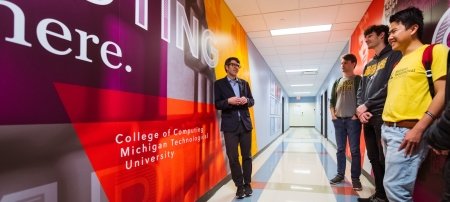A picture is said to be worth a thousand words — but it can require many more to create art with artificial intelligence. As the second annual Art in Silico computational art show comes to the Keweenaw from April 2-5, entrants and event planners share their creative processes and the larger meaning behind the event.
“The world around us is quickly being affected by AI, one pixel at a time,” said Tim Havens, director of Michigan Technological University’s Institute of Computing and Cybersystems (ICC). “Art in Silico is a platform by which community members can not only learn about the capabilities and limitations of AI and computational tools for creativity, but also take part in critical and important debates about the role of technology in media, expression, invention, innovation and creativity.”
While maintaining an open and honest discussion about ethical frameworks, Art in Silico celebrates the upside of AI, specifically examining how it can enhance human creativity and innovation. There are 20 entries this year, submitted for the juried exhibition by faculty, students, staff and community members. Entrants chose their own themes and media forms, with submissions ranging from visual art to more abstract entries.
Havens said the event debuted in 2023 as a way to “hack your mind” to reveal the vast intersection between science, technology, engineering and math (STEM) and the arts. College of Computing Dean Dennis Livesay said he’s excited to see how submissions have evolved in the exhibition’s second year.
"The Art in Silico event series attracts a diverse audience. Community members, MTU students and faculty researchers from many disciplines participate to challenge the way we view the relationship between technology and the arts."
About the Event
Art in Silico’s 2024 opening reception will take place from 4:30-5:30 p.m. on Thursday, April 4, at Copper Country Community Arts Center, where entries will be displayed from April 2-5. Following the gallery reception, there will be a main reception from 5:30-7:45 p.m. at the Orpheum Theater, where the winners will be announced.
The Art in Silico event series will also feature a keynote address from Chantal Rodier, STEAM project coordinator and artist in residence at the University of Ottawa. Rodier's keynote, titled "Generative AI breaking artistic and programming barriers," is at 5 p.m. Wednesday, April 3, in Room 202 of the Great Lakes Research Center.
Check out the Art in Silico website for more information and the event schedule.
Planning members of this year’s event include the ICC and Great Lakes Research Center, as well as Michigan Tech’s College of Computing, College of Engineering, College of Arts and Sciences, and Department of Visual and Performing Arts.
Trust the Process
Exhibitors whose works remain on display in the 2023 Art in Silico Virtual Gallery include health informatics graduate student Yogendra Kanchapu, who received an honorable mention for his entry, “4,000 AD, a Portrait of Houghton.” To create his artwork, he used Midjourney, an AI image generator.

“When using Midjourney or any similar AI tool, transfer learning, which is a subset of machine learning, can be leveraged by beginning with a model trained on a broad array of images and styles,” said Kanchapu. “Then, to achieve the utopian and serene depiction of Houghton, I refined this model with data that emphasizes peaceful, futuristic cityscapes and harmonious architectural designs. This method relies on the AI’s ability to synthesize and extrapolate from its training to create something that feels both idealistic and grounded in a potential future reality.”
Kanchapu said the field of computational art is evolving rapidly, noting that ethics regarding AI and integrity are a hot topic of discussion, with legislative and legal proceedings actively debating the societal framework for the rapidly emerging technology.
“AI and machine learning offer tools that can expand the artist’s palette in unprecedented ways,” he said. “There’s a potential for these tools to democratize art creation, making it accessible to those without traditional artistic training. However, there are also valid concerns regarding the originality and authenticity of AI-generated art, the potential for it to be used in creating deepfakes and the implications for copyright and attribution.”
"It will be paramount to balance innovation with ethical considerations and respect for the traditional principles of artistic creation."
Other displays in the 2023 gallery include an entry by Evan Lucas titled “Emails from Dean Lovecraft,” a fictional collection of college announcement emails composed in the style of horror fiction author H.P. Lovecraft.
Lucas, now a research scientist with ICC, had several years’ worth of emails — more than 80 in his inbox — to draw upon for his project, having earned his bachelor’s, master’s and Ph.D. degrees in mechanical engineering at Tech. Using those emails as a starting point, he experimented with a variety of styles and tools until he found the tone he was seeking.

"I tried using a few different training strategies, all of which started from a pre-trained large language model,” said Lucas. “I used the entire anthology of Lovecraft, whose works are classic horror largely focused on otherworldly beings and metaphysical contemplations. I attempted to use some Dr. Seuss texts. I also tried including some emails from the Enron email dataset, although that ended up not improving results appreciably because corporate discussions really don’t mix in well with the fantastical and absurd.”
Lucas is not a Lovecraft buff — though he’s interested in reading more of his works someday. He chose Lovecraft because the style meshed with his artistic vision and the author’s catalog is in the public domain, meaning Lucas could download it in a single file for easy use. “The strategy I ended up going with was training on a blend of actual emails and excerpts of Seuss or Lovecraft augmented to look like emails,” Lucas explained. “I had a list of greetings (‘Hello Huskies,’ ‘Dear MTU Students,’ etc.) and a list of closings extracted from the real emails. I sandwiched excerpts of the texts between the greeting and closing so that it looked like an email. I then trained on a blend of these different fake and real emails and experimented with varying ratios.”
For his efforts, Lucas earned the Most Innovative Award in last year’s show.
Exhibit jurors at this year’s Art in Silico will determine the 2024 winners of the Most Innovative, Best in Show and Most Creative awards, along with honorable mentions across categories.
Cynthia Cote, executive director of Copper Country Community Arts Center, said CCCAC is excited to expand its participation in Art in Silico.
“Last year, the staff served on the jury panel, and this year we will do the same — but this year we will also host the exhibition in our Kerredge Gallery, providing an opportunity for more community members to also see the work,” she said. “My hope is that, by providing the exhibition venue, we will encourage local studio artists to see how they might approach the intersection of art and technology in their own work and add to the conversation around Art in Silico.”
Article author James Townsend is research coordinator for the ICC.
Michigan Technological University is an R1 public research university founded in 1885 in Houghton, and is home to nearly 7,500 students from more than 60 countries around the world. Consistently ranked among the best universities in the country for return on investment, Michigan's flagship technological university offers more than 120 undergraduate and graduate degree programs in science and technology, engineering, computing, forestry, business, health professions, humanities, mathematics, social sciences, and the arts. The rural campus is situated just miles from Lake Superior in Michigan's Upper Peninsula, offering year-round opportunities for outdoor adventure.






Comments